Did you know that there’s a hidden gem among bottom-dwelling fish?
Meet the kuhli loach – a lesser-known species that’s just as captivating and efficient as their more popular counterparts.
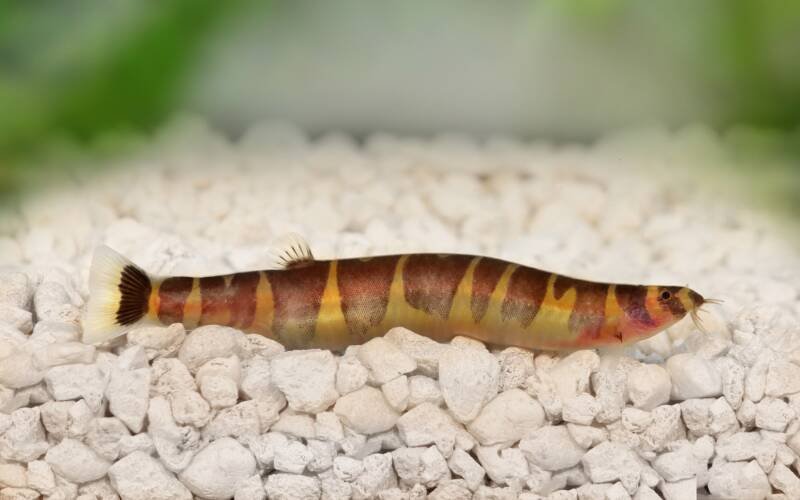
These eel-like fish may not be the most popular bottom dwellers, but they are certainly among the most dedicated members of your aquarium’s clean-up crew.
They are also the perfect addition to any community tank and an ideal choice for those seeking a unique, eel-like fish.
However, caring for kuhli loaches requires some knowledge and attention to detail. These fish thrive in groups, so be sure to purchase at least five of them. Failure to do so can result in stress and even death among your loaches.
Keep reading to learn more about caring for kuhli loaches and providing them with the environment they need to thrive.
At a Glance
| Minimum tank size: | 20 gal (80 l) |
| Temperature: | 73-86°F (23-30°C) |
| Lifespan: | up to 10 years |
| Size: | 4 inches (10 cm) |
| pH: | 5.5-6.5 |
| Hardness: | 0-5 dGH |
| Ammonia: | < 2 ppm |
| Nitrite and nitrate: | 0 ppm |
In this article
Look and Lifespan
Kuhli loaches (Pangio kuhlii) have long, thin, eel-like bodies. It has short, translucent fins and four sets of barbels around its mouth and fins.
Both its fins, barbels, and underbelly are extremely delicate and sensitive.
They also have a layer of transparent skin covering and protecting their eyes. They have body scales (also hard to see but still visible) but no head scales. This unique characteristic that also has the unfortunate side effect of making them vulnerable to disease.

These fish can grow up to 4 inches long. And with the right water conditions and under the watchful eye of more experienced aquarists, they can live up to 10 years.
Some other common names for this fish are the coolie loach, the leopard loach, the chocolate loach, and the cinnamon loach. These last two names specifically refer to black kuhli loaches.
Coloration and Banding Patterns
Loaches are a yellow or orange color with brown vertical bands.
These bands run the length of their body, from their nose all the way to their caudal fins. They cross over the loach’s back but don’t reach down to their underbelly. These bands are the only color visible on their fins, which are otherwise translucent.
They generally come in two color variations: “regular” and black.
The “regular” color variation is described above.
Black kuhli loaches have almost inverted colors. They do have a yellow, orange, or light brown base color, but it is nearly covered by the thick bands of black that cover their body.
These bands are wider and longer than the bands in the “regular” variation, so much so that at a first glance black seems to the base color.
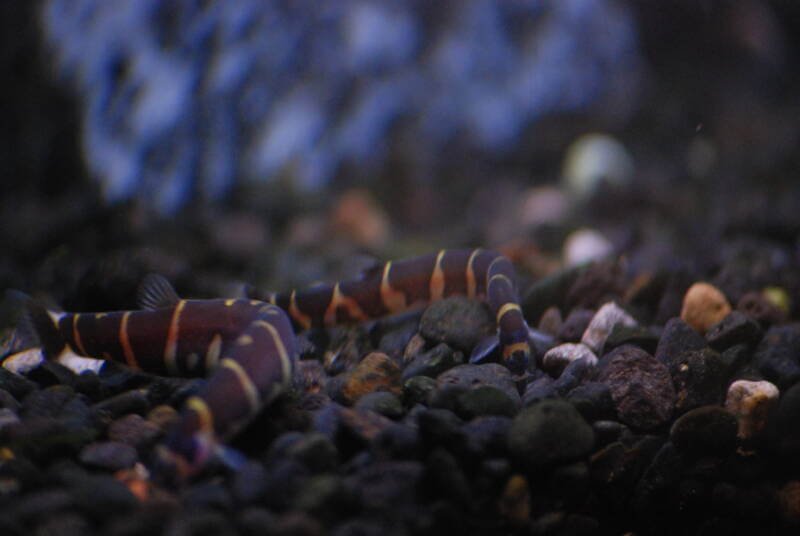
Sexing
It can be difficult to tell the difference between male and female kuhli loaches.
Outside of the breeding season, the only way to sex them is by examining their body. Males will have a more muscular dorsal cross-section and may have larger pectoral fins.
However, this can be difficult to see. Because of this, it’s easiest to wait until they’re ready to mate.
When preparing for spawning, female loaches will become longer. Onlookers will also be able to see their ovaries, which can be seen through their skin.
Common Loach Behaviors
The kuhli loach is one of the more peaceful freshwater fish and makes an excellent addition to any community aquarium.
It is a peaceful fish with a shy temperament and will get along with similarly-behaved tank mates. Other docile fish will encourage the loaches to be more active, though they will never be overly energetic.
Though they are not a schooling fish, they do prefer to have some companions of the same species. They’ll never be overly confident or active, but this will make them feel more comfortable.
They are most active at night and prefer to avoid bright lights and active areas of the tank. In the dark, you’ll be able to see them venture out and show their natural behavior.
They spend the majority of their time scavenging for food, but will also take time to explore the tank and any crevices you create for them.
Burrowing in the substrate is another common pastime for this fish, which is why sand is recommended. They like tunneling and enjoy the opportunity to search for even more food.
Natural Habitat
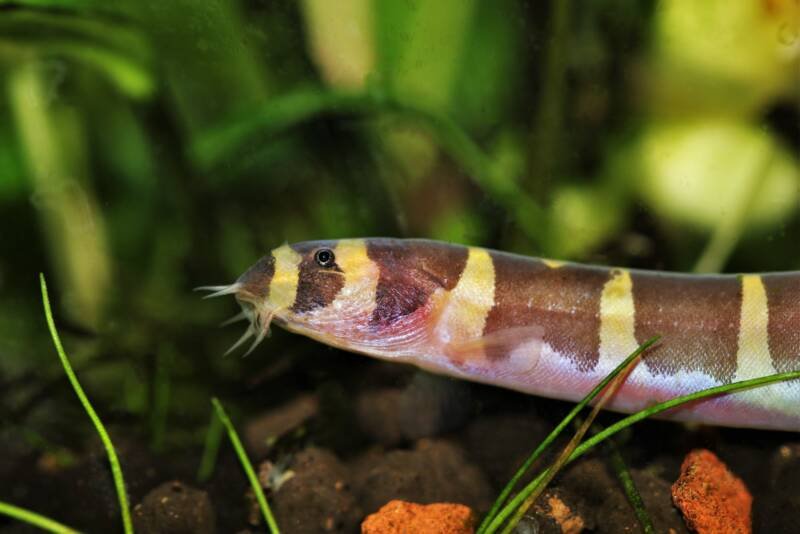
In the wild, the kuhli loach is found in Southeast Asia, around Malaysia, Sumatra, and Borneo specifically. However, it is suspected that they are more widespread than this.
They live in shallow, warm, and slow-moving water. Forest streams are their habitat of choice.
These streams feature dense vegetation under the water and a thick tree canopy above. Because of this, loaches are not used to much direct sunlight. They prefer plants to provide shelter both within and on top of the water.
The water here is very acidic. It also tends to have low mineral content due to decaying plants and other organic material.
This creates one of the only difficulties in placing kuhli loaches in community environments. Much other fish do not thrive in such a low pH range.
Along the streambed, the substrate varies by area. It can be rocks and pebbles, mud and peat, or sand.
Kuhli loaches prefer areas with softer substrates that won’t damage their underbellies or barbels.
Tank Setup
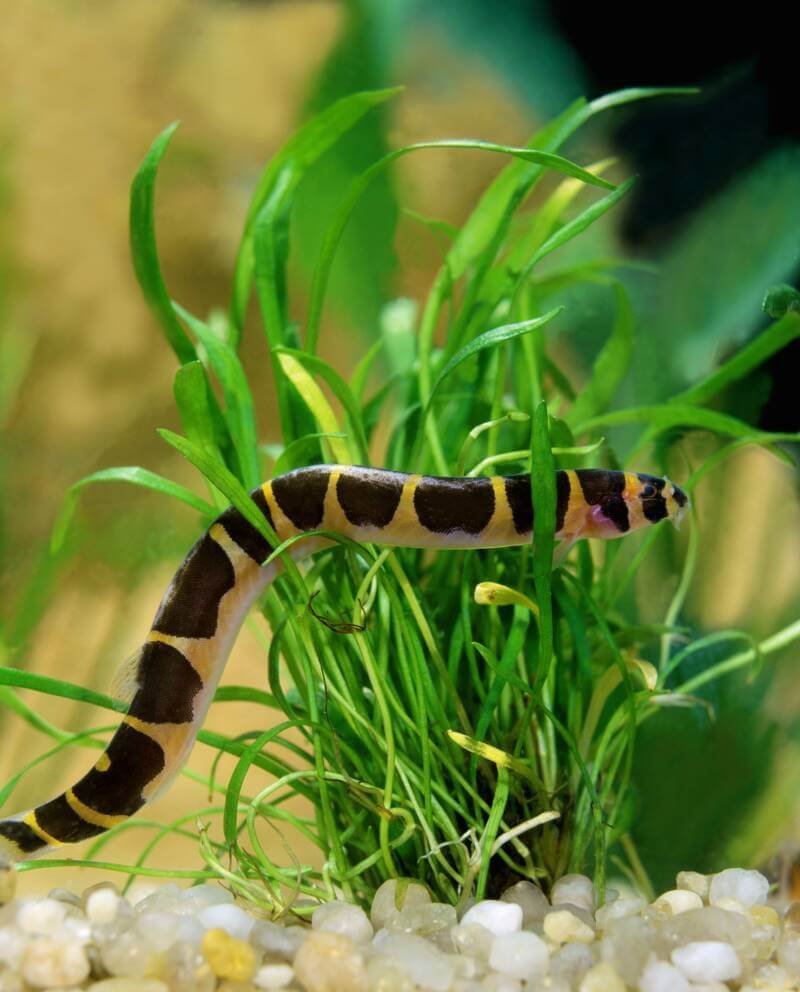
An individual loach needs a minimum of 20 gallons. An extra ten gallons should be added for each addition loach or fish.
This means that community aquariums can usually 50 gallons or larger.
Because of the specificity of their natural habitat, it can be difficult to recreate this in aquarium setup. However, it’s still possible for dedicated aquarists determined to keep kuhli loaches.
Required Tank Equipment and Tips to Consider
Each element of the aquarium is just as important to the overall health of the kuhli loach as the other elements.
A specific substrate is recommended. But keeping live plants and appropriate filtration is just as important.
All of these necessary tank elements and equipment are outlined below.
- Filtration: Filters that produce a lot of water movement or a powerful output are not recommended. This fish prefers a low current with minimal water movement that won’t disturb the substrate or dislodge it from its hiding place.
- Filter Covers: A common problem with kuhli loaches is that they either explore or are sucked into filter intake and outtake pipes, slats, etc. Because of this, all types of filters (HOB, undergravel, all of them) will need covers.
- Heating: This tropical fish needs to be kept warm, so a heater and thermometer are necessary equipment. And since kuhli loaches enjoy higher temperatures but can overheat easily, a fan may also be advisable.
- Vegetation: Live plants are essentially a must-have for this fish since it feeds off them and uses them as a primary form of protection. Floating plants are also recommended since this fish is most comfortable with shaded surfaces.
- Lighting: A plant-rated light is necessary to keep aquarium plants alive and thriving. Lights should be at least 4500K. LED lights are recommended for their longevity and light cycle customization options, but are not necessary.
- Driftwood: Though driftwood is not essential for tanks with kuhli loaches, they do provide a convenient place to hide and explore. They can also help to naturally lower the tank’s pH, which loaches always appreciate.
- Caves and Décor: If driftwood is not provided, caves and other décors will be necessary to provide shelter for these fish. They are not only cautious creatures but also naturally curious. Both characteristics require places to shelter in and investigate.
- Substrate: A soft substrate is required so as to not damage kuhli loaches, which are delicate. Sand and a very fine gravel mix are two popular substrate choices and can both support live plants with regular nutrient dosings.
All elements of the aquarium will need to work in tandem to recreate the natural habitat of the kuhli loach.
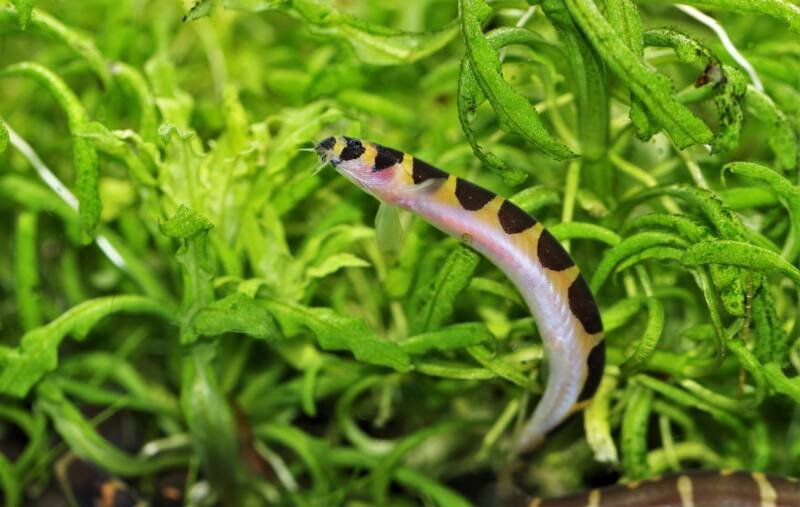
The plants, driftwood, and décor are arguably the most integral. They provide meals, shelter, and enrichment for loaches. They also decide what type of substrate and lighting will be used.
Aquarists should take extra care when considering which types of ground and floating plants to incorporate.
Water Parameters
The pH and dGH are the two water parameters that are the most specific and maybe the hardest to reconstruct.
They are also the two elements that may restrict other tank inhabitants, or keep owners from placing loaches in an already established community aquarium.
However, those who can successfully meet all the water parameters below will be rewarded with thriving kuhli loaches. This is by no means an easy feat.
- Temperature: These fish are truly tropical and enjoy warmer temperatures ranging from 73 to 86°F. However, they don’t do well in water that is heated above this top number, so keepers should keep a close eye on the thermometer.
- pH Range: As discussed earlier, kuhli loaches prefer slightly acidic water. Water with a pH that falls within the 5.5 to 6.5 range is perfect for these fish. This range also has the benefit of being healthy for many other fish.
- Hardness: Loaches prefer softer water that ranges from 0 to 5 dGH. This is a relatively limited range as compared to other tropical freshwater fish, but is still acceptable for many tank inhabitants.
- Ammonia: kuhli loaches are very sensitive to water parameters, which is why regular weekly water changes of at least 20% are necessary. Ammonia levels should be kept low, preferably under 2 ppm at all times.
- Nitrites: Just like ammonia, loaches are sensitive to nitrite levels and can suffer negative health effects as a result of even low levels. To avoid this, hobbyists should strive to keep nitrite levels as close to 0 ppm as possible.
- Nitrates: Perhaps even worse than ammonia and nitrites, prolonged exposure to nitrates can have devastating effects on an aquarium population. Owners should perform regular maintenance and testing to ensure nitrates stay at 0 ppm.
These water parameters can be harder to establish and maintain. This is the main reason why kuhli loaches are not recommended for beginners.
Aquarists with previous experience are best suited to keeping loaches and setting up an appropriate environment.
Suitable Tank Mates for Community Setup
Kuhli loaches have a peaceful but tentative temperament. Because of this, these fish are best kept with other peaceful fish that are not overly rambunctious.
Fish that prefer the middle and upper levels of the tank are also recommended. Loaches will gladly share the bottom of the tank but may be less active as a result. Some common and popular tank mates include:
And, of course, other loaches! Kuhli loaches do best when kept in groups of at least half a dozen.
The more loaches you have, the more confident and comfortable they will likely become.
The one exception to this list is snails, which kuhli loaches may try to eat. Though they probably won’t be successful, this could stress your snails out and cause adverse health effects.
Avoid aggressive, territorial, and overly active fish.
Even if they don’t directly harass the loaches, they will still cause undue stress and provoke the loaches to hide. In turn, this can cause feeding issues.
What to Feed Kuhli Loaches
Kuhli loaches are primarily scavengers and will search the bottom of the tank and surrounding areas for food.
However, this doesn’t mean that you shouldn’t provide them with regular meals. A clean tank often means scarce food for bottom dwellers, especially those as industrious as these fish.
Some of the best foods to feed kuhli loaches include:
- Plant material
- Insects and larvae
- Brine shrimp
- Bloodworms
- Daphnia
- Artemis
- Microworms
- Grindal worms
- Flakes and pellets
- Vegetables
Loaches should be fed at least twice per day but no more than four times per day, for increments of two to three minutes each.
Only put in the food they can eat during this time period.
If you notice their stomachs bulging or their sides seem distended, stop feeding immediately. Keep a close eye on them to make sure the bloating goes down.
Closing Thoughts
Kuhli loaches are not suitable for beginners due to their specific requirements regarding water parameters and tank setup.
However, they are a rewarding fish to keep for those who have experience with tropical fish and other bottom dwellers.
Loaches are interesting and dynamic creatures that, while shy, show a remarkable variety of behaviors.
It is fascinating to watch their systematic scavenging and curios explorations.
Though not common, it’s undeniably true that kuhli loaches are nonetheless amazing.